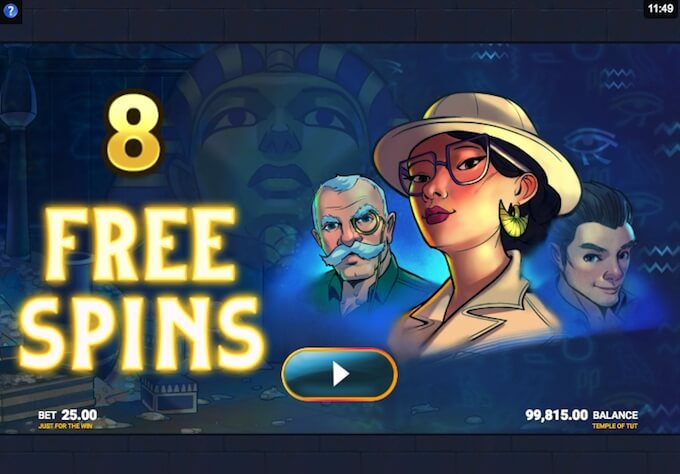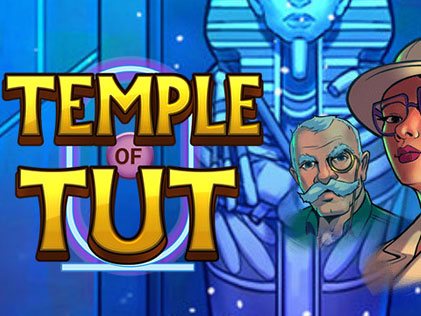- Temple Of Tutankhamun Walkthrough
- Egyptian Temple Architecture
- Temple Of Tutankhamun Treasure
- Temple Of Tuthmosis Iii Excavated In 1996
On April 28, 1967, United States President Lyndon B. Johnson awarded an ancient Egyptian temple built in the first century B.C.—a gift from Egypt to the United States—to The Metropolitan Museum of Art. Today the structure, the Temple of Dendur in The Sackler Wing, is one of the iconic and most beloved works of art at The Met. This crossword clue Where to find the Egyptian Temple of Dendur, with 'the' was discovered last seen in the January 21 2021 at the New York Times Crossword. The crossword clue possible answer is available in 3 letters. This answers first letter of which starts with M and can be found at the end of T. Tutankhamun’s tomb (innermost coffin and death mask) Essay by Dr. Elizabeth Cummins. Mortuary Temple of Hatshepsut and Large Kneeling Statue, New Kingdom, Egypt. Temple of Tut slot free spins with Super Reels on every spin. So in the base game Super Reels can show up randomly, however, trigger the free spins by finding 3 or more of the Temple of Tut free spins bonus symbol and you’ll get Super Reels on every spin. Find 3, 4 or 5 free spins symbols and you’ll get 8, 15 or 30 free spins respectively.
If you enjoy this review of the Temple of Tut slot, you may want to check out some similar options. Maybe you want to help Rich Wilde out in the Book of Ra slot from Novomatic. This game also comes with free spins and special expanding symbols. Additionally, the Temple of Tut slots game is similar to Rise of Egypt from Playson. The wild symbol in this slot expands across the entire reel it shows up on and will.
Treasure of Tutankhamun is one of the new riddles in AC Origins, introduced in the Curse of The Pharaohs add-on. It’s a puzzle that points towards a treasure, much like the papyrus puzzles before it. It’s much more difficult to decipher, though. It’s a tricky thing, and we spent quite a while trying to figure it out. We’re going to present the solution in our AC Origins Treasure of Tutankhamun guide, for all those who need help with it.
Treasure of Tutankhamun Puzzle
The text is a bit unhelpful. It narrows your search down to Duat, and points you behind the Funeral Parlor point of interest, but the rest is up to you. The river flowing through the area is rich with pillars (none of which are behind the parlor), and there are lotus flowers literally everywhere. The Wadjet clue is completely irrelevant, as that is something you’ll notice only when you’re already past the biggest hurdle.
Behind the eternal parlor, Lotus scented he liesFrom the flowing waters pillars loom in darkness
“Hidden” is the name of the fifth of the Duat
Revealed beyond the jaws of the cobra-headed Wadjet.
Where to find Treasure of Tutankhamun?
Go behind the Funeral Parlor in the southwestern corner of Duat. Go down to the river and inspect the southern cliff. You should see a small opening near the water level. Squeeze through,and you’ll end up in a cavern. Go across the chamber, into the tomb-like room, and crawl through the hole on the right. Look around the room, and you’ll soon find a white chest with your prize. We got the Golden Wolf sword, but it seems the rewards are random. Whatever you get, it will certainly be of legendary rarity, though.
The Temple of Dendur in the Metropolitan Museum of Art, New York, USA.

The Temple of Dendur (Dendoor in nineteenth century sources) is an ancient Egyptiantemple that was built by the Roman governor of Egypt, Petronius, around 15 BC, as one of many Egyptian temples commissioned by the emperor Augustus. It was dedicated to Isis and Osiris, as well as two deified sons of a local Nubian chieftain, Pediese ('he whom Isis has given') and Pihor ('he who belongs to Horus').[1] In the 1960s, the temple was removed from its original location and given to the Metropolitan Museum of Art in New York, USA, where it has been exhibited since 1978.
Architecture and artwork[edit]
19th century graffiti
The temple is constructed from sandstone and measures 25 meters (82 feet) from the front stone gate to its rear as well as 8 meters (26 feet) from its lowest to its highest point. A 30-meter (98-foot) cult terrace overlooks the Nile.[1] From the gate, two flanking walls ran around the temple and isolated the structure from the cult terrace and the Nile river.[1] The temple is partly decorated with reliefs: the temple base is decorated with carvings of papyrus and lotus plants growing out of the water of the Nile, which is symbolized by depictions of the god Hapy. Over the temple gate as well as over the entrance to the temple proper, depictions of the Winged sun disk of the sky god Horus represent the sky. This motif is repeated by the vultures depicted on the ceiling of the entrance porch. On the outer walls, Emperor Augustus is depicted as a pharaoh making offerings to the deities Isis, Osiris, and their son Horus. The subject is repeated in the first room of the temple, where Augustus is shown praying and making offerings. Augustus is identified as 'Caesar' (actually, 'Qysrs', which is based on 'Kaisaros', the Greek version of Caesar). He is also called 'Autotrator', an alteration of autokrator, or autocrat, the Greek equivalent of imperator, one of the emperor's titles. This misspelling seems to be deliberate, in order to achieve more symmetry in the hieroglyphs. In some other parts of the temple, however, the emperor is simply called 'Pharaoh'. The middle room, which was used for offerings, and the sanctuary of Isis at the rear of the temple are undecorated but for reliefs on the door frame and backwall of the sanctuary. The latter shows Pihor and Pedesi as young gods worshiping Isis and Osiris respectively. The 6.55 by 13 meters (21.5 by 42.7 feet) temple house is modest but well executed in design with two front columns, an offering hall and a sanctuary with a statue niche.[1] A crypt was also built into the rear wall while a rock chamber in the nearby cliffs may have represented the tombs of Pediese and Pihor who were said to have drowned in the Nile river.[1]
In the 19th century, graffiti were left on the temple walls by visitors from Europe. One of the most prominent pieces of graffiti ('A L Corry RN 1817', at eye level to the left as one enters the temple) was left by the British naval officer and later Rear Admiral Armar Lowry Corry. Another inscription was left by the Italian Egyptologist Girolamo Segato.

Relocation[edit]
The Temple of Dendur in its original location. Drawing by Henry Salt.
The temple was dismantled and removed from its original location (modern name: Dendur, ancient name: Tuzis, about 80 kilometers (50 miles) south of the town of Aswan) in 1963. This was accomplished as part of a wider UNESCO project,[2][3] in order to save significant sites from being submerged by Lake Nasser, following construction of the Aswan High Dam.[1] In recognition of the American assistance in saving various other monuments threatened by the dam's construction, Egypt presented the temple and its gate as a gift to the United States of America, represented by Jacqueline Kennedy among others, in 1965. The stone blocks of the temple weighed more than 800 tons in total with the largest pieces weighing more than 6.5 tons. They were packed in 661 crates and transported to the United States by the freighter m/v Concordia Star. In the United States, several institutions made bids for housing the temple, in a competition that was nicknamed the 'Dendur Derby' by the press. Alternative plans proposed re-erecting the temple on the banks of the Potomac River in Washington, D.C. or on the Charles River in Boston. However, these suggestions were dismissed because it was feared that the temple's sandstone would suffer from the outdoor conditions. On April 27, 1967, the temple was awarded to The Metropolitan Museum of Art, where it was installed in the Sackler Wing in 1978. Inside the Sackler Wing, designed by the architects Kevin Roche, John Dinkeloo, and associates, a reflecting pool in front of the temple and a sloping wall behind it represent the Nile and the cliffs of the original location. The glass on the ceiling and north wall of the Sackler is stippled in order to diffuse the light and mimic the lighting in Nubia.
Temple Of Tutankhamun Walkthrough
See also[edit]
The four temples donated to countries assisting the relocation are:

- Temple of Debod (Madrid, Spain)
- Temple of Dendur (Metropolitan Museum of Art, New York, United States)
- Temple of Taffeh (Rijksmuseum van Oudheden in Leiden, the Netherlands)
- Temple of Ellesyia (Museo Egizio, Turin, Italy)
References[edit]
Egyptian Temple Architecture
- ^ abcdefArnold, Dieter (1999). Temples of the Last Pharaohs. Oxford University Press. pp. 244.
- ^Monuments of Nubia-International Campaign to Save the Monuments of Nubia World Heritage Committee, UNESCO
- ^The Rescue of Nubian Monuments and Sites, UNESCO
External links[edit]
| Wikimedia Commons has media related to Temple of Dendur. |
- Digitized material related to the Temple of Dendur in the Digital Collections from The Metropolitan Museum of Art Libraries
Temple Of Tutankhamun Treasure
Coordinates: 23°22′59″N32°57′00″E / 23.38306°N 32.95000°E
Temple Of Tuthmosis Iii Excavated In 1996
Retrieved from 'https://en.wikipedia.org/w/index.php?title=Temple_of_Dendur&oldid=1005311552'